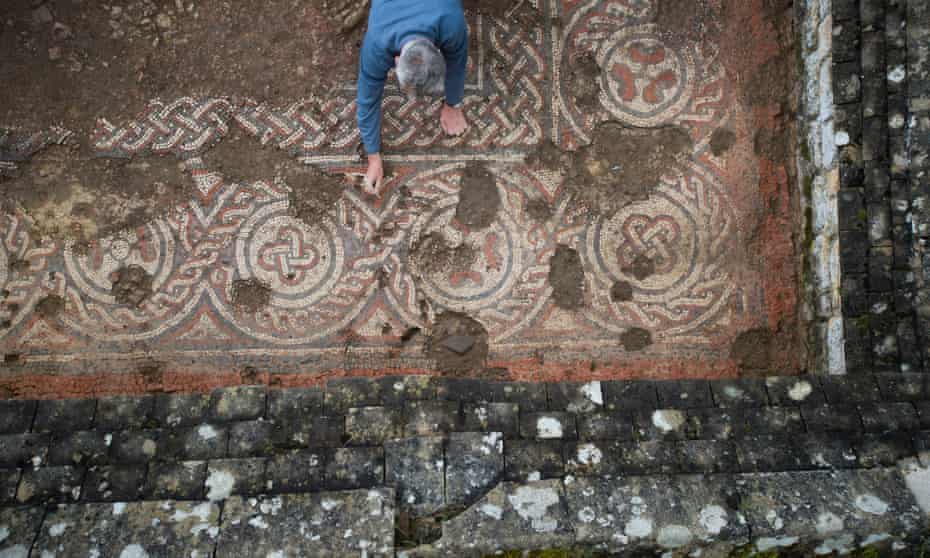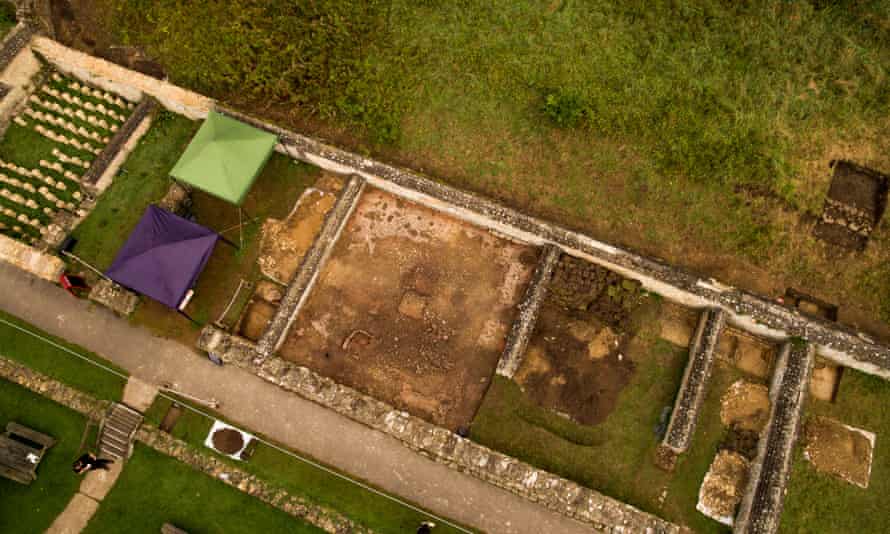
During the summer of 1978 I bicycled with two friends through England's West Country and wrote about some of that trip in Avebury Redux (which sets out the entire itinerary). Prior to arriving in Avebury, we'd ridden through the lovely Cotwold Hills and outside Cirencester, stopped to see Chedworth Villa, a 4th century Roman villa that had been partially excavated.
Recent excavations at Chedworth may lead to revisions of the accepted account of the end of Roman Britain.
The accepted account starts with the Roman invasion in 43 AD, at the time of the Emperor Claudius, with the area south of the current border with Scotland occupied by the 70s. Over time, towns are rebuilt on the Roman model and the Roman lifestyle is adopted by the British tribal elite as well as retired soldiers from the three Legions stationed on the island.
The island was generally prosperous and may have benefited during the 3rd century from an influx of wealthy landowners from Gaul, which suffered much from barbarian raids during that era. Historians and archeologists believe the height of prosperity was reached during the first half of the 4th century with a remarkable flourishing of large villas, particularly in the West Country. Over the past half century, investigations have revealed that Britain became so stable and prosperous that it's population was much higher than previously believed, possibly reaching well over 4 million in the 4th century, a figure not exceeded for the next 1,000 years of English history.
Various rebellions and increased raids from Scots via land and Irish and Germans by sea lead to a period of decline later in the 4th century. As the rest of the Roman Empire came under increasing barbarian pressure, British garrisons were run down as troops were moved to the continent. The last evidence we have of coinage being sent to pay the British garrison is in 402. In 406 or 407, the increasing chaos led the British legions to proclaim one of their commanders as emperor and he took the name Constantine III. He took most of the remaining garrison across the English Channel and into Gaul. Initially he was successful, bringing barbarian incursions in Gaul under control and with the province of Spain endorsing his claim as emperor. However, by 409 the situation had changed and Constantine was losing ground (he was to be murdered in 411). That year or in the following year the Romano-British elite decided that rather than continue to pay taxes for dubious benefit they would expel the remaining Roman officials and govern themselves.
At that point, Britain falls out of documented history for some time, only emerging two centuries later in a grouping of kingdoms dominated by Anglo-Saxons.
Several things are thought to have happened during those first two or three decades of the 5th century.
(1) Politically, the province broke up into many different areas, each ruled by local elites, with conflict beginning to erupt between them.
(2) With no new coinage coming in, and none being minted, it became harder to support mass production local industries such as pottery and tile manufacturers and the need for large scale skilled work forces declined. Imports were also sharply reduced. From being part of an integrated economy, connected with the Mediterranean world, Britain became an isolated outpost.
(3) Though decline had begun in the latter part of the 4th century, the process accelerated in the early 5th for Roman based town and villa life, with town populations diminishing and public systems like water supply and public buildings not being maintained, with villas either abandoned, or with sections abandoned and the remaining portions converted to cramped living quarters.
(4) Roman control of the provinces on the other side of the English Channel became shakier, virtually ceasing by the 430s, further reducing communication.
(5) Several of the new British statelets, particularly those bordering the North Sea, began recruiting German tribesmen as mercenaries to protect them from Irish, Scottish and other German incursions.
(6) Eventually the Germans revolted, killed many of the British and began seizing control of territory, slowly moving west until defeated in the late 5th century at Mount Badon by British forces led by Ambrosius Aurelianus, a descendant of Roman-British nobility. Despite his Roman name, Aurelianus and others like him were more like warlords, leading warrior bands from their hillfort bastions. After being stymied for several decades, a renewed German offensive brought the rest of England, excluding Wales and Cornwall, under control in the last quarter of the 6th century.
In recent decades evidence has been uncovered that the decline of post-Roman Britain may not have been as precipitous as previously thought, particularly away from the North Sea coast and Kent in the southeast. Evidence of new building and water piping has been discovered in some towns. There is still clear evidence of decline but many towns may have existed as recognizable entities well into the 5th century before finally succumbing.
And that brings us back to Chedworth, one of the largest villas of the Romano-British period, with 35 rooms, located just a few miles from Cirencester, by the end of the 4th century the second-largest town, after London, in Britain. Archaelogists have recently announced the dating of a new room and mosiac unearthed at the villa (shown in the photo at top). The room was built no earlier than 424 with the mosiac installed later. Though not of the same quality as 4th century mosiacs, it indicates the survival of enough of an industry to supply the tile and skilled designers and workmen to install, something not previously thought possible in the 2nd quarter of the 5th century.
(Rooms at Chedworth)

This article from The Guardian contains more details.
"What is so exciting about the dating of this mosaic at Chedworth is that it is evidence for a more gradual decline. The creation of a new room and the laying of a new floor suggests wealth, and a mosaic industry continuing 50 years later than had been expected."
Stephen Cosh, a Roman mosaic expert, said in a statement: "I am still reeling from the shock of this dating.""There are very late Roman mosaics in the area for which archeology can only ever say they must be later than a particular date, without being able to say how much later," Cosh added."But none has ever been suspected to be this late. It will be important to research further sites in the region to see whether we can demonstrate a similar refurbishment at other villas which continued to be occupied in the 5th century. But there is no question that this find at Chedworth is of enormous significance -- it's tremendously exciting."

No comments:
Post a Comment